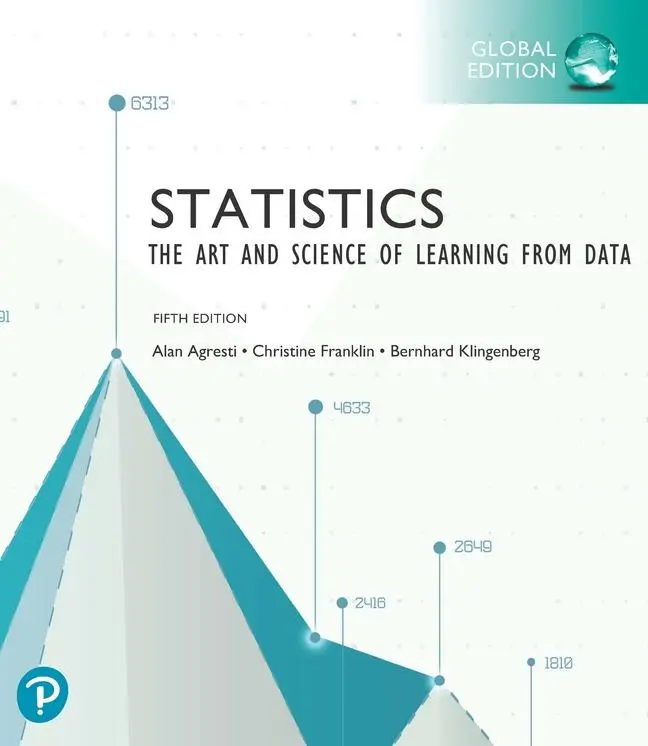113,95 €
Versandkostenfrei per Post / DHL
Lieferzeit 1-2 Wochen
Statistics: The Art and Science of Learning From Data, 5th Edition
helps you understand what statistics is all about and learn the right questions to ask when analyzing data, instead of just memorizing procedures. It makes accessible the ideas that have turned statistics into a central science of modern life, without compromising essential material. Students often find this book enjoyable to read and stay engaged with the wide variety of real-world data in the examples and exercises. Based on the authors' belief that it's important for you to learn and analyze both quantitative and categorial data, this text pays greater attention to the analysis of proportions than many other introductory statistics texts.
Key features include:
- Greater attention to the analysis of proportions compared to other introductory statistics texts.
- Introduction to key concepts, presenting the categorical data first, and quantitative data after.
- A wide variety of real-world data in the examples and exercises
- New sections and updated content will enhance your learning and understanding.
Pearson MyLab
ï¿¿
Students, if Pearson Pearson MyLab Statistics is a recommended/mandatory component of the course, please ask your instructor for the correct ISBN. Pearson MyLab Statistics should only be purchased when required by an instructor. Instructors, contact your Pearson representative for more information.
Statistics: The Art and Science of Learning From Data, 5th Edition
helps you understand what statistics is all about and learn the right questions to ask when analyzing data, instead of just memorizing procedures. It makes accessible the ideas that have turned statistics into a central science of modern life, without compromising essential material. Students often find this book enjoyable to read and stay engaged with the wide variety of real-world data in the examples and exercises. Based on the authors' belief that it's important for you to learn and analyze both quantitative and categorial data, this text pays greater attention to the analysis of proportions than many other introductory statistics texts.
Key features include:
- Greater attention to the analysis of proportions compared to other introductory statistics texts.
- Introduction to key concepts, presenting the categorical data first, and quantitative data after.
- A wide variety of real-world data in the examples and exercises
- New sections and updated content will enhance your learning and understanding.
Pearson MyLab
ï¿¿
Students, if Pearson Pearson MyLab Statistics is a recommended/mandatory component of the course, please ask your instructor for the correct ISBN. Pearson MyLab Statistics should only be purchased when required by an instructor. Instructors, contact your Pearson representative for more information.
Alan Agresti is a Distinguished Professor Emeritus in the Department of Statistics at the University of Florida. He taught statistics there for 38 years, including the development of e-courses in statistical methods for social science students and three courses in categorical data analysis.
He is the author of more than 100 refereed articles and six texts, including Statistical Methods for the Social Sciences (Pearson, 5th edition, 2018) and An Introduction to Categorical Data Analysis (Wiley, 3rd edition, 2019). Alan has also received teaching awards from the University of Florida and an Excellence in Writing award from John Wiley & Sons.
Christine Franklin is the K-12 Statistics Ambassador for the American Statistical Association and elected ASA Fellow. She has retired from the University of Georgia as the Lothar Tresp Honoratus Honors Professor and Senior Lecturer Emerita in Statistics.
She is the co-author of two textbooks and has published more than 60 journal articles and book chapters. Chris was the lead writer for the American Statistical Association Pre-K-12 Guidelines for the Assessment and Instruction in Statistics Education (GAISE) Framework document, co-chair for the updated Pre-K-12 GAISE II, and chair of the ASA Statistical Education of Teachers (SET) report.
Bernhard Klingenberg is a Professor of Statistics in the Department of Mathematics & Statistics at Williams College, where he has been teaching introductory and advanced statistics classes since 2004. He teaches statistical inference and modelling as well as data visualisation at the Graduate Data Science Program at New College of Florida.
Prof. Klingenberg is responsible for the development of the web apps, which he programs using the R package Shiny. A native of Austria, he frequently returns there to hold visiting positions at universities and gives short courses on categorical data analysis in Europe and the United States. He also enjoys photography, with some of his pictures appearing in this book.
PART I: GATHERING AND EXPLORING DATA
• Statistics: The Art and Science of Learning from Data• Exploring Data with Graphs and Numerical Summaries
• Exploring Relationships Between Two Variables
• Gathering Data
PART II: PROBABILITY, PROBABILITY DISTRIBUTIONS, AND SAMPLING DISTRIBUTIONS
• Probability in Our Daily Lives• Sampling Distributions
PART III: INFERENTIAL STATISTICS
• Statistical Inference: Confidence Intervals• Statistical Inference: Significance Tests About Hypotheses
• Comparing Two Groups
PART IV: ANALYZING ASSOCIATION AND EXTENDED STATISTICAL METHODS
• Analyzing the Association Between Categorical Variables• Analyzing the Association Between Quantitative Variables: Regression Analysis
• Multiple Regression
• Comparing Groups: Analysis of Variance Methods
• Nonparametric Statistics
| Erscheinungsjahr: | 2022 |
|---|---|
| Fachbereich: | Wahrscheinlichkeitstheorie |
| Genre: | Importe, Mathematik |
| Rubrik: | Naturwissenschaften & Technik |
| Medium: | Taschenbuch |
| Inhalt: | Kartoniert / Broschiert |
| ISBN-13: | 9781292444765 |
| ISBN-10: | 1292444762 |
| Sprache: | Englisch |
| Einband: | Kartoniert / Broschiert |
| Autor: |
Agresti, Alan
Franklin, Christine A. Klingenberg, Bernhard |
| Auflage: | 5. Auflage |
| Hersteller: |
Pearson
Pearson Education Limited |
| Verantwortliche Person für die EU: | Pearson, St.-Martin-Str. 82, D-81541 München, salesde@pearson.com |
| Maße: | 274 x 212 x 31 mm |
| Von/Mit: | Alan Agresti (u. a.) |
| Erscheinungsdatum: | 15.09.2022 |
| Gewicht: | 1,856 kg |












